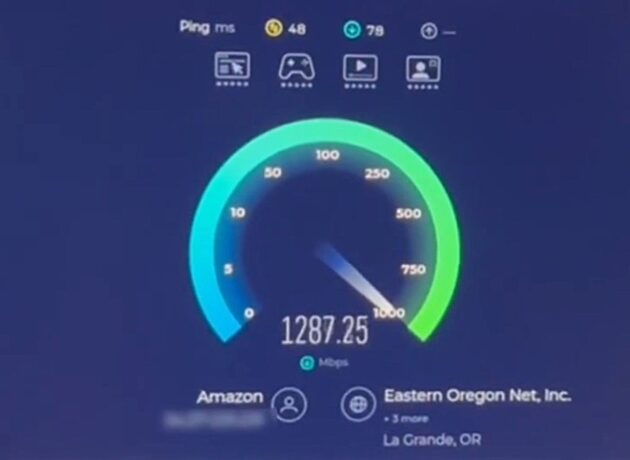Amazon executives are showing off evidence that the company’s Project Kuiper satellite constellation is capable of transmitting data at speeds in excess of a gigabit per second.
The evidence is in the form of a video posted to social-media accounts, displaying an internet speed test that hit a peak downlink transfer rate of over 1.2 Gbps.
Panos Panay, Amazon’s senior vice president for devices and services, said Project Kuiper team members used Amazon’s enterprise-grade customer terminal for the test, and connected as their satellites flew above at their assigned altitude of 630 kilometers (390 miles).
“So pumped to see this, and looking forward to bringing this level of performance to our customers,” Panay wrote on LinkedIn.
Rajeev Badyal, Amazon’s vice president of technology for Project Kuiper, weighed in on LinkedIn as well. “The team set a high bar from the start, and as far as we know, this is the first commercially phased array antenna to deliver 1+ Gbps from low Earth orbit,” he wrote.
“P.S.: Uplink numbers generated as much excitement (if not more),” Badyal added. “We’ll save those for another day though…”
Project Kuiper has had 102 satellites launched so far, with another 27 satellites due to go into orbit as early as this month. The current schedule calls for half of the planned 3,232-satellite constellation to be deployed within the next year, but that schedule may have to shift to the right.
Amazon has said it intends to begin delivering satellite broadband services to customers by the end of this year. Eventually, it aims to offer high-speed internet access to millions of people around the globe. Details about pricing and availability haven’t yet been announced.
SpaceX’s Starlink network currently dominates the market for broadband access via satellites in low Earth orbit. Starlink has more than 8,000 satellites in orbit and more than 6 million subscribers worldwide. SpaceX says Starlink can currently provide downlink speeds amounting to hundreds of megabits per second, and it’s aiming to start offering gigabit service to selected coverage areas next year at a premium.
Network congestion can have a significant impact on downlink speeds, so Amazon’s internal test of satellite data transfer rates may not reflect how Project Kuiper would perform once customer service starts. What’s more, the enterprise-grade terminal is expected to be more capable than the consumer-grade terminal.
In short, your mileage may vary.
Read the full article here










